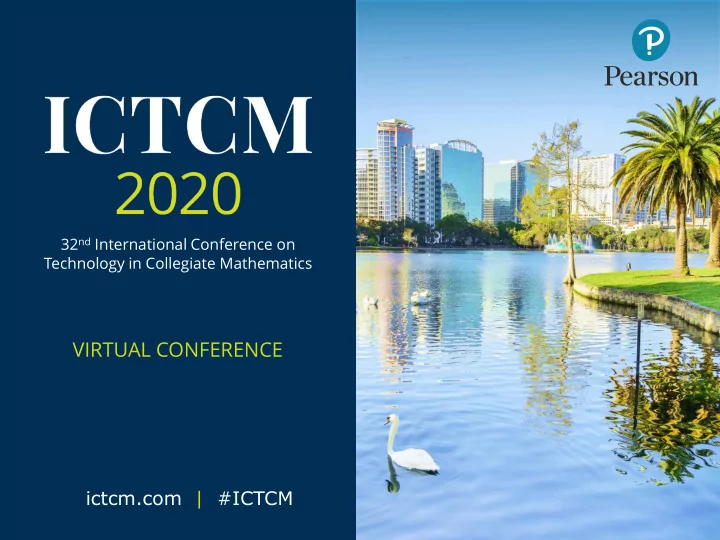

32 nd International Conference on Technology in Collegiate Mathematics VIRTUAL CONFERENCE ictcm.com | #ICTCM
32 nd International Conference on Technology in Collegiate Mathematics VIRTUAL CONFERENCE #ICTCM Gives us a Break! Dr. F. Strazzullo, Reinhardt University
32 nd International Conference on Technology in Collegiate Mathematics VIRTUAL CONFERENCE #ICTCM Attention Span Johnstone & Percival (1976), Hartley & Davies (1978), McKeachie & Svinicki (2006), Bunce et al. (2010), Wilson & Korn (2007), Munoz-Luna & Jurado-Navas (2016)
32 nd International Conference on Technology in Collegiate Mathematics VIRTUAL CONFERENCE #ICTCM Routine Breakers Lectures frequently are passively monotonous, • causing boredom and drowsiness Low Doses of a Medication, often • Engaging Working Memory • Active Learning through Learning Games • Game-Based Learning • Gamification and Serious Games • Nairne (1996), Killen (2007), de Byl (2013), Silapachote & Srisuphab (2014), Munoz-Luna & Jurado-Navas (2016), Karagiorgas & Niemann (2017)
32 nd International Conference on Technology in Collegiate Mathematics VIRTUAL CONFERENCE #ICTCM Gamification • Digital Educational Games • Moderate to Strong Effect on Cognitive Learning Outcomes • Rich Primers for Active Learning • Multimodal Representation and Visualization of Information • Simulated Problem Solving • Instant Feedback Kangas et. al. (2017), An & Cao (2017), Ke (2016), Ito (2008)
32 nd International Conference on Technology in Collegiate Mathematics VIRTUAL CONFERENCE #ICTCM Example for Calculus 1 • Kahoot! • After Game Surveys – Indirect Measure • In Game Answers • Pre-assessment or Post-assessment • Synchronous or Asynchronous Here is the game
32 nd International Conference on Technology in Collegiate Mathematics VIRTUAL CONFERENCE #ICTCM References 1/2 An, Y.- J., & Cao, L. (2017). The Effects of Game Design Experience on Teachers’ Attitudes and Perceptions regarding the Use of Digital Games in the Classroom. TechTrends: Linking Research & Practice to Improve Learning, 61(2), 162 – 170. https://doi.org/10.1007/s11528- 016-0122-8 Bunce, D. M., Flens, E. A., & Neiles, K. Y. (2010). How Long Can Students Pay Attention in Class? A Study of Student Attention Decline Using Clickers. Journal of Chemical Education, 87(12), 1438 – 1443. http://dx.doi.org/10.1021/ed100409p de Byl, P . (2013). Factors at play in tertiary curriculum gamification. International Journal of Game-Based Learning, 3(2), 1 – 21. Hartley, J., & Davies, I. K. (1978). Note taking: A critical review. Programmed Learning and Educational Technology, 15, 207 – 224. Ito, M. (2008). Education vs. entertainment: A cultural history of children’s software. The ecology of games: Connecting youth, games, and learning (pp. 89 – 116). Cambridge: MIT Press.Johnstone & Percival (1976), Kangas, M., Koskinen, A., & Krokfors, L. (2017). A qualitative literature review of educational games in the classroom: the teacher’s pedagogical activities. Teachers & Teaching, 23(4), 451. https://doi.org/10.1080/13540602.2016.1206523 Karagiorgas, D. N., & Niemann, S. (2017). Gamification and Game-Based Learning. Journal of Educational Technology Systems, 45(4), 499 – 519. http://dx.doi.org/10.1177/0047239516665105
32 nd International Conference on Technology in Collegiate Mathematics VIRTUAL CONFERENCE #ICTCM References 2/2 Ke, F . (2016). Designing and integrating purposeful learning in game play: a systematic review. Educational Technology Research & Development, 64(2), 219 – 244. https://doi.org/10.1007/s11423-015-9418-1 Killen, R. (2007). Effective teaching strategies: lessons from research and practice, 4th ed. South Melbourne, Vic.: Thomson Social Science. McKeachie, W. J., Svinicki,M. (2006). McKeachie’s teaching tips: Strategies, research, and theory for college and university teachers (12th ed.). Boston: Houghton-Mifflin. Munoz-Luna, R., & Jurado-Navas , A. (2016). Routine Breakers for Emotionally Active Learning: “A Case Study.” International Journal of Higher Education, 5(4), 52– 62. [Retrieved from http://search.ebscohost.com/login.aspx?direct=true&AuthType=ip,shib&db=eric&AN=EJ11138 17&site=eds-live&scope=site&custid=ken1] Nairne, J. S. (1996). Short-term/working memory. In E. L. Bjork & R. A. Bjork (Eds.), Memory (pp. 101 – 126). San Diego, CA: Academic. Silapachote, P ., & Srisuphab, A. (2014). Gaining and maintaining student attention through competitive activities in cooperative learning A well-received experience in an undergraduate introductory Artificial Intelligence course. 2014 IEEE Global Engineering Education Conference (EDUCON), Global Engineering Education Conference (EDUCON), 2014 IEEE, 295 – 298. https://doi.org/10.1109/EDUCON.2014.6826106 Wilson, K., Korn, J. H. (2007). Attention During Lectures: Beyond Ten Minutes. Teaching of Psychology, 34(2), 85 – 89. https://doi.org/10.1080/00986280701291291
32 nd International Conference on Technology in Collegiate Mathematics VIRTUAL CONFERENCE #ICTCM Contact Information Dr. Francesco Strazzullo Associate Professor of Mathematics Reinhardt University fs1@reinhardt.edu @DrFr_Strazzullo
Recommend
More recommend